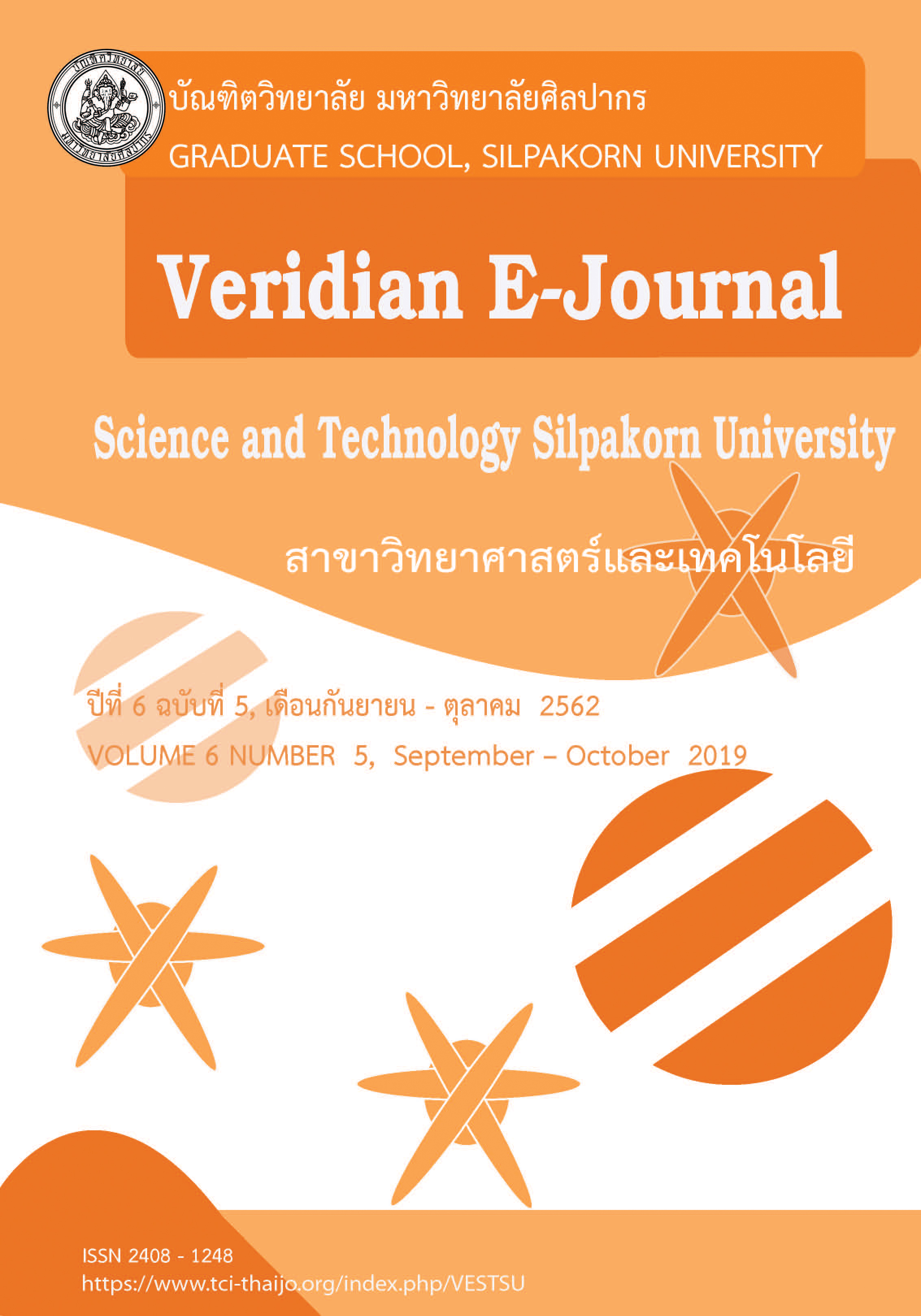การใช้กากมันสำปะหลังเหลือทิ้งจากอุตสาหกรรมเกษตรเป็นตัวประสานในการอัดแท่ง ผงถ่านจากเปลือกตาลโตนด (Utilization of Cassava Residue from Agro-Industry as Binder with Powder of Palmyra Palm fruit Peel Charcoal for Briquettes Fuel Production)
Main Article Content
Abstract
งานวิจัยนี้เป็นการศึกษาการนำกากมันสำปะหลังที่เป็นของเหลือทิ้งจากอุตสาหกรรมการเกษตรมาเป็นตัวประสานร่วมกับผงถ่านจากเปลือกตาลโตนดมาใช้ประโยชน์ในรูปเชื้อเพลิงอัดแท่งและใช้แป้งมันสำปะหลังเป็นชุดการทดลองควบคุม เพื่อศึกษาลักษณะและคุณสมบัติของเชื้อถ่านอัดแท่งที่ทำจากวัสดุเหลือทิ้งรวมถึงมีการทดสอบคุณสมบัติของเชื้อเพลิงก่อนนำไปเปรียบเทียบกับเกณฑ์มาตรฐานผลิตภัณฑ์ชุมชนเรื่องถ่านอัดแท่ง (มผช.238/2547) โดยออกแบบอัตราส่วนของผงถ่านจากเปลือกตาลโตนด: ตัวประสาน เป็น 5 ชุดการทดลองคือ 3:0.5, 3:1.0, 3:1.5, 3:2.0 และ 3:2.5 โดยน้ำหนัก ตามลำดับ
จากการศึกษาพบอัตราส่วนที่เหมาะสมระหว่าง ผงถ่านจากเปลือกตาลโตนด:แป้งมันสำปะหลังและผงถ่านจากเปลือกตาลโตนด:กากมันสำปะหลัง คืออัตราส่วน 3:2.0 และ 3:1.5 มีความหนาแน่นเท่ากับ 0.48 และ 0.43 กิโลกรัมต่อลูกบาศก์เมตร ดัชนีการแตกร่วนเท่ากับ 0.84 และ 0.93 ความชื้นเท่ากับ 6.62 และ 10.45 เปอร์เซ็นต์ ปริมาณสารระเหยเท่ากับ 11.82 และ 6.61 เปอร์เซ็นต์ ปริมาณเถ้าเท่ากับ 0.36 และ 1.22 เปอร์เซ็นต์ คาร์บอนคงตัวเท่ากับ 81.19 และ 78.70 เปอร์เซ็นต์ ค่าความร้อน 5,690 และ 5,241 แคลอรี่ต่อกรัม และประสิทธิภาพของเชื้อเพลิง 24.60 และ 23.26 เปอร์เซ็น ตามลำดับ เมื่อเปรียบเทียบเกณฑ์มาตรฐานผลิตภัณฑ์ชุนชนถ่านอัดแท่งพบว่าถ่านอัดแท่งจากผงถ่านเปลือกตาลโตนดผ่านเกณฑ์มาตรฐาน สามารถนำไปพัฒนาเพื่อการใช้งานได้
This research investigated the utilization of the cassava waste from the agricultural industry as the binding agent in the compressed fuel production by combining it with the charcoal powder made of palmyra palm shells. In the control sets, the tapioca starch as the binding agent. The characteristics and properties of the charcoal briquettes made of the waste materials were studied and the fuel quality was also examined and compared to the Thai Community Product Standard of charcoal briquettes (TCPS 238/2004). In total of 5 sets, the different mixing ratios of the charcoal powder to the binding agent were determined by weight as 3:0.5, 3:1.0, 3:1.5, 3:2.0, and 3:2.5 respectively.
The study found that the appropriate mixing ratios of the charcoal powder to the tapioca starch and to the cassava waste were 3:2.0 and 3:1.5. These ratios showed the density of 0.48 and 0.43 kg/m3, the shatter index of 0.84 and 0.93, the 6.62% and 10.45% of moisture, the 11.82% and 6.61% of volatile matter, the 0.36% and 1.22% of ash content, the 81.19% and 78.70% of fixed carbon, the calorific value of 5,690 and 5,241 Cal/g, and the 24.60% and 23.26% of combustion efficiency. Compared to the TCPS of charcoal briquettes, the produced charcoal briquettes from the palmyra palm shells exceeded the standard and can be improved for practical uses.

